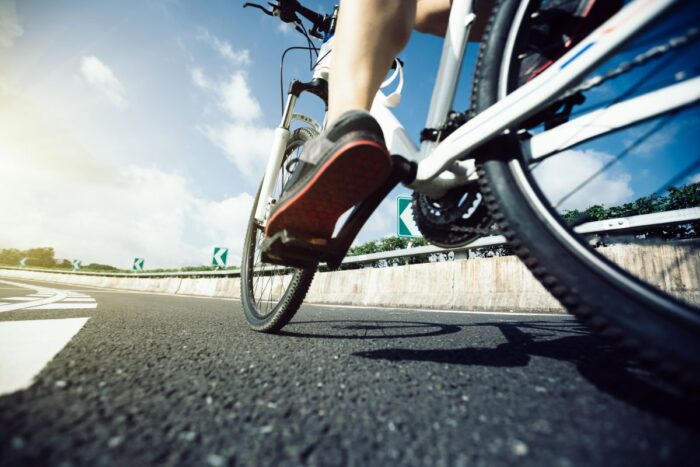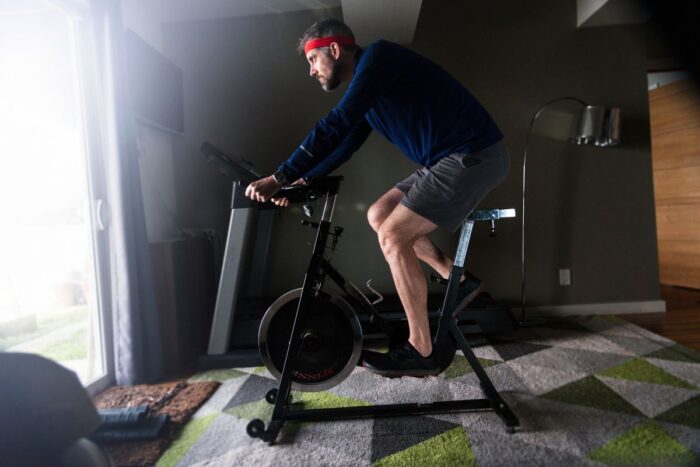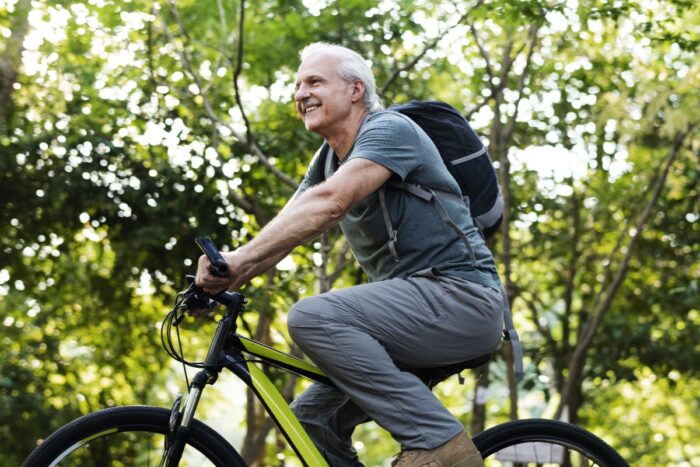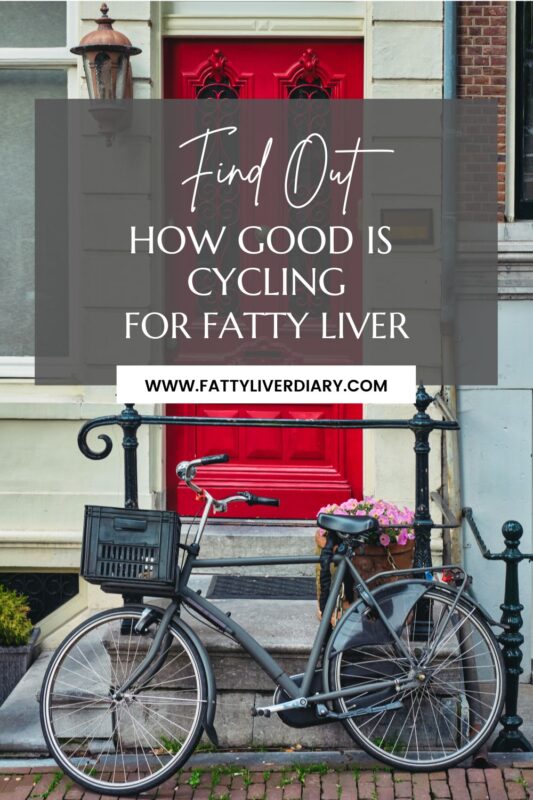Getting regular exercise is great for reversing fatty liver, alongside eating a healthy diet. Cycling or biking is one of these types of exercises and you might be wondering whether or not it’s a good fit for fatty liver (aka NAFLD).
Cycling is one of the exercises that you can simply fit into your daily routine and is probably one of the easiest to get into. But is it really helpful for fighting against fatty liver?
Definitely, cycling is considered a great type of exercise for reversing NAFLD. It will help reduce the fat amount in and around your liver. It also has other important health benefits that make it a perfect choice for your daily routine.
First of all, I would say that any type of exercise is better than no exercise at all. A simple walk to the grocery store or riding your bicycle to work is already beneficial to your overall health. Especially if you want to reverse a fatty liver.
But a part of the lifestyle changes that you must make in order to get your health back in shape is getting some higher intensity workouts – biking included.
I personally waited for a few months before starting to exercise (as I was already losing weight too fast) but once I hit that plateau, it was cardio exercising such as cycling that helped me continue.
Why Is Cycling Good for Your Liver?

Biking is good for fatty liver because it can reduce hepatic fat content – the fats surrounding your liver – thus helping your quest of reversing fatty liver and preventing non-alcoholic fatty liver disease.
Fatty liver, especially NAFLD (non-alcoholic fatty liver), is associated with obesity. Cycling helps lower body fat levels since exercise reduces body inflammation and builds lean muscle mass to replace fat.
So the next time you are thinking of burning those excess calories, go grab your bike and start cycling!
The liver is our body’s largest internal organ and one of its important functions is to detoxify and neutralize toxins. Cycling is also a good way to get our blood pumping thus promoting better blood circulation and better cleansing effects.
It is a low-impact aerobic exercise: believe it or not, it causes less strain or injuries than most other workouts.
It is also one of the best ways to reduce the risk of developing health problems such as cardiovascular and liver diseases. Or, as it is our case, help fix existing problems.
Some other health benefits of cycling include things that might not be directly related to NAFLD, although some can be:
- Increased muscle strength and flexibility
- Improves joint mobility
- Ease feelings of stress, anxiety, and depression
- Improves cognitive function
- Improves balance, coordination, and gait
Cycling is not only environment-friendly but also beginner-friendly. If you have a hard time balancing on a standard bike, then you can opt for a stationary bicycle.
What Is a Stationary Bicycle?
A stationary bicycle is an exercise equipment for indoor cycling. It’s really just your typical standard bicycle, minus the wheels.
This is best to use if you’re not a fan of the outdoors or don’t know how to ride a standard bicycle.

Stationary cycling allows you to exercise right in the comforts of your living room, even while binge-watching your favorite Netflix series.
What makes it more interesting is that you can still reap most of the health benefits you get from riding a standard bicycle.
While you can do this by going to a local gym, you can easily install one at home. Here are three cheaper options that you can get at home to start cycling your way back to full health (the links below are affiliate links):
- Yosuda Indoor Stationary Cycling Bike – a cost-effective choice that offers fantastic stability during rides. It can hold a maximum of 270 Pounds.
- Schwinn IC3 Indoor Cycling Bike – comes with a fully adjustable ventilated race-style seat. It can hold around 300 pounds and is highly rated by customers.
- Pooboo Magnetic Resistance Indoor Cycling Bike – a budget option that is still pretty effective. For weights up to 300 lbs.
How Often Should You Cycle if You Have NAFLD?
The American College of Sports Medicine recommends at least 150 minutes per week of cycling activity for anyone with chronic liver disease, including fatty liver.
You can start light with around 10-20 minutes per day, then gradually increase it to 30-60 minutes a day as you get used to doing intense cycling every day.
As with other exercises and physical activity, be sure to do a little warm-up before you start cycling and take time to cool down afterward.
This helps improve your flexibility and lessen the risk of injury and muscle soreness. And remember: whenever you feel uncomfortable, just stop, take a break and try again later.
When I started exercising after being diagnosed, I was shocked to see that I was only able to cycle at a very fast pace for just 5 minutes straight.
But I took it from there and kept improving until I managed to get a full session of 45 minutes of intense practice without too much trouble.
Does Cycling REALLY Help Fatty Liver?

We have a research study in the Molecular Metabolism journal which showed that cycling helps prevent fatty liver disease. It was even demonstrated to help put NAFLD into remission in men.
Of course, it’s not cycling alone that can achieve this: any type of cardio / aerobic exercise can have the same level of success. But yes, this includes biking – which is a good thing, since it’s one of the easier things to do when it comes to exercising.
The University of Eastern Finland supports cycling as an integral part of the treatment of NAFLD after a 12-week randomized controlled study. Cycling helps lower excess delivery of free fatty acids and glucose synthesis to the liver.
But anyway, it’s always a good idea to first check with your doctor and proceed with caution on any exercise or physical activities you participate in.
Other Exercises that Are Good for Fatty Liver
Other aerobic exercises – swimming, walking, running – had been proven effective in helping reverse fatty liver disease according to a study conducted by the Alimentary Pharmacology and Therapeutics.
But there are times when some patients with fatty liver, especially NAFLD, find aerobic exercises tiresome, so a better alternative would be resistance training exercises.
It also has significant advantages in reducing liver fat as well as total body fat.
They say two is better than one, so the best thing you can do to reverse fatty liver is to combine aerobic and resistance training exercises alongside a healthy diet. This was my approach, too.

Conclusion
Doing regular exercise is beneficial not only to liver-related diseases but to your overall health.
I recommend performing physical exercise, be it aerobic, resistance, or a combination of both, for at least 30 minutes a day or 3 hours per week. I am not always able to do it daily, but aim for at least 4 times per week. But every day is better!
Just keep in mind to talk to your doctor before you start cycling or engage in any of these exercises and maybe also a personal trainer to get some guidance at least early on.
So what are you waiting for? Get that bike off your garage (or order one on Amazon) and start cycling!

I was diagnosed with a fatty liver back in 2014 and managed to reverse it by mid-2015. Since then, I’ve been studying it, continuously updating my knowledge with the latest scientific findings and practical approaches to give others the help they need to reverse their condition.
My approach to managing fatty liver is holistic, balancing scientifically-backed information with real-life, practical advice based on personal, direct experience.
I am also the admin of the Fatty Liver Support Group on Facebook and the Fatty Liver Subreddit.

